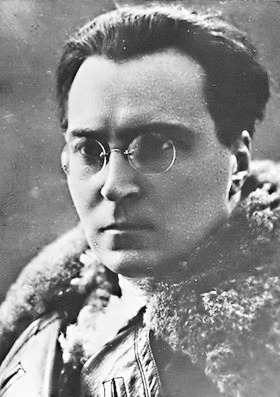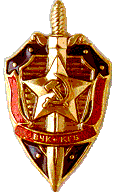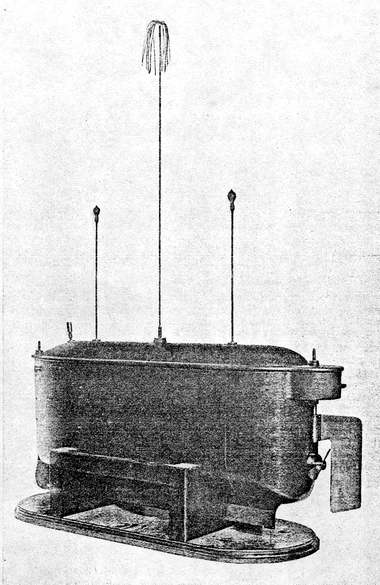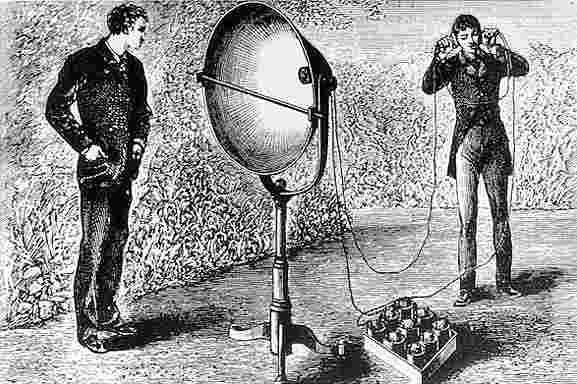A Knight in Sour Armor
Childish Fears
One daydream that almost all of us had is to be a hero. The heroes of our daydreams vary as we grow and so do our ideas of what distinguishes a heroes from everyone else. Our ideas develop and become more sophisticated. One of my earliest ideas of a hero was that of the white knight. My father trough a staunch model socialist in all other aspects of life had a great fondness of western medieval fantasy, such as the epic tales of King Arthur. Well hidden from any visitors who might belittle his taste, he kept an entire collection of Alexander Grin's books hidden in a special cupboard, as well as anything else that could fulfill his craving for fantastic escapism.
Alexander Grin
So, it is not surprising that he was overjoyed when he read an article written by the “Commissar of Enlightenment ” Lunarchasky himself praising Richard Wagner on the 50th anniversary of his death:
"We speak often and justly of the hypnotising, enchanting power of Wagner’s music. No other composer before Wagner had burst upon the listeners’ perception with such a cascade of sound, with such a broad river of harmony, with such poignant melodies. Wagner himself called his music an endless melody. This may be understood not only in the direct sense, i.e., in the sense of a continuously unrolling musical canvas, but in the sense that Wagner’s music seems to create an invisible magnetic field that extends throughout the universe, and penetrates to the very soul of the listener.
The thunder and clashing of his cymbals, his colossal ensembles, his unisons, which catch one up and carry one off – the entire well-planned whirlwind of sound is staggering. However, Wagner is nearly as powerful when he wants to be winning, when he creeps up to our subconscious unawares. Then he uses the most delicate of skeleton keys to make his way into the very depths of the human heart.
When they say that Wagner was, first and foremost, a man of iron will, that he craved for power above all, one cannot but agree. Indeed, music to him is like an assembly of spirits which he marshals and sends marching forward, to win millions of human souls for him. (Pravda 1933) [1]
Whenever somebody would take offense in his taste from now on, he could always refer to Lunacharsky's thoughts. Who in his right mind would question the socialist credentials of Bogdanov's right hand?
So as you can imagine my bedtime stories were filled with evil dragons and heroic knights slaying them. Literal knights in shining armor were my idea of true heroes. However, once I grew up one particular difficulty arose again and again. How do you identify a hero in a world without dragons, without magic or clear cut villains? A world that is neither black nor white. A world filled with gray places. One of those places was and to a certain extend still is the Lubyanka. Whenever I had to cross the Lubyanka Square I always got the urge to move faster, not too fast thou, I didn't want to look suspicious.
I can't really explain what made me feel so uneasy about this place. Many things may have contributed. One of my earliest encounters with the Lubyanka was a very indirect one but nevertheless it left its mark. When I was around ten years old my parents had guests over at night and I couldn't sleep so I sneaked downstairs from my room and sat down far enough from the door of the living room that nobody would notice me. I was careful not to make any noise. It was fun sitting there, listening to the adults talking about strange and sometimes sexually crude stuff. All good material to impress my friends in school with the forbidden things I knew, to show them how mature I already was. The atmosphere was very relaxed, music played from the radio the entire time. I remember one song in particular, it was Ol' Man River by Paul Robeson. There was something mysterious about this song, a foreign language I never heard before until this point. I still can get lost listening to Robeson full-bodied and sonorous voice singing.
Somebody began telling jokes and other friends followed. I don't know who asked '"What is the tallest building in Moscow ?" but suddenly everybody became silent and uneasy for a moment. Then everybody was chatting again as if nothing ever happened.
Maybe I was a little to sensitive as a child, but the question and the peoples reaction to it didn't leave me alone. Things weren't helped by the fact that I was a terrible curious child as well. I really wanted to know the answer to the question.
Asking my parents might have tipped them off that I stayed awake, so I asked my teacher instead. She should know the answer I thought, teachers have to know all kinds of things after all. The answer I got wasn't obviously the punch line to the joke but a straight answer. The tallest building in Moscow she knew would have to be the newly erected Tatlin Tower, the new seat of the Interkom [2]. It was all over the news at the time.
For all who are curious by now, the punch line is "The Lubyanka since you can see Siberia from the basement." A harmless little joke, at least in the mid thirties, but the memory of the Class War and the Cheka was still lingering. A few years ago I realized it was silly to still get worrisome in front of the Lubyanka so I confronted my fears and walked slowly up to statue in the central place.
There on his pedestal he was standing "Iron Felix" Dzerzhinsky. On a little, carefully polished silver plate was written "Felix Dzerzhinsky: Hero of the Sovetunio". Once again I was confronted with this nagging question. What is a hero? Was he one? First here a the facts about Dzerzhinsky that are public knowledge...
The Life of Felix Dzerzhinky
Felix Dzerzhinsky was born into a purported Polish szlachta (noble) family of the Samson coat of arms on 11 September 1877. As a youngster Dzerzhinsky was fluent in three languages: Polish, Russian and Hebrew. He attended the Russian gymnasium at Vilnius 1887–95. One of the older students at this gymnasium was the future commandeer of Poland's reactionary forces Józef Piłsudski.
Even after his release from the hard labour camp Piłsudski recalled without hesitation that Dzerzhinsky "distinguished himself as a student with delicacy and modesty. He was rather tall, thin and demure, making the impression of an ascetic with the face of an icon. ... Tormented or not, this is an issue history will clarify; in any case this person did not know how to lie."
Two months before graduating, Dzerzhinsky was expelled from the gymnasium for "revolutionary activity". He had joined a Marxist group, the Union of Workers and became later one of the founders of Social Democracy in the Kingdom of Poland and Lithuania in 1899. He spent a large part of his early life in various prisons. He was sent to Kovno, to take advantage of the arrest of the Polish Socialist Party branch. He worked in a book-binding factory and set up an illegal press.
As an organizer of a shoemaker's strike, Dzerzhinsky was arrested for "criminal agitation among the Kovno workers" and the police files from this time state that: "Felix Dzerzhinsky, considering his views, convictions and personal character, will be very dangerous in the future, capable of any crime."
He was arrested for his revolutionary activities, sent to Siberia, but escaped two times. He then traveled to Berlin and met with Rosa Luxemburg and Leo Jogiches, two prominent leaders of the Polish Social Democratic movement at the time. Dzerzhinsky went to Switzerland where his fiancée Julia Goldman was undergoing treatment for tuberculosis. She died in his arms on 4 June 1904. Her illness and death depressed him, and in letters to his sister, Dzerzhinsky explained that he no longer saw any meaning for his life. That changed with the Russian Revolution of 1905 as Dzerzhinsky was involved with work again. After the revolution failed, he was again jailed, this time by the Okhrana. He later escaped after which he spent much time abroad, and together with Jogiches reorganized the party. In many ways the party began to be more similar philosophically to the Bolshevik faction of the Russian Social Democratic Labor Party.
Back in Kraków in 1910 Dzerzhinsky married party member Zofia Muszkat, who was already pregnant. A month later she was arrested and she gave birth to their son Janek in Pawiak prison. In 1911 Zofia Dzerzhinska was sentenced to permanent Siberian exile, and she left the child with his father. Dzerzhinsky saw his son for the first time in March 1912 in Warsaw. In attending the welfare of his child, Dzerzhinsky repeatedly exposed himself to the danger of arrest.
On one occasion, Dzerzhinsky narrowly escaped an ambush that the police had prepared at the apartment of his father-in-law. Dzerzhinsky remained in Warshaw to direct the Social Democratic Party, while considering his continued freedom "only a game of the Okhrana". The Okhrana, however, was not playing a game; Dzerzhinsky simply was a master of conspiratorial techniques and was therefore extremely difficult to find. A police file from this time says: "Dzerzhinsky continued to lead the [Social Democratic] party and at the same time he directed party work here [in Warsaw], he led strikes, he published appeals to workers ... and he traveled on party matters to Łódź and Kraków". The police however were unable to arrest Dzerzhinsky until the end of 1912, when they found the apartment where he lived, by the name of Władysław Ptasiński
Dzerzhinsky would spend the next four and one-half years in czarist prisons, first at the notorious Tenth Pavilion of the Warsaw Citadel. When the Great War began in 1914, all political prisoners were relocated from Warsaw into Russia proper. Dzerzhinsky was taken initially to Oryol. He was very concerned about the fate of his wife and son, with whom he did not have any communication. Moreover, Dzerzhinsky was beaten frequently by the Russian prison guards, which caused the permanent disfigurement of his jaw and mouth. In 1916 Dzerzhinsky was moved to the Moscow Butyrka prison, where he was soon hospitalized because the chains that he was forced to wear had caused severe cramps in his legs. Despite the prospects of amputation, Dzerzhinsky recovered and was put to labor sewing military uniforms.
Felix Dzerzhinsky was freed from Butyrka after the March Revolution of 1917. Soon after his release, Dzerzhinsky's goal was to organize Polish refugees in Russia and then go back to Poland and fight for the revolution there, writing to his wife: "together with these masses we will return to Poland after the war and become one whole".
However, he remained in Moscow where he joined the Bolshevik party, writing to his comrades that "the Bolshevik party organization is the only Social Democratic organization of the proletariat, and if we were to stay outside of it, then we would find ourselves outside of the proletarian revolutionary struggle".
Already in April he entered the Moscow Committee of the Bolsheviks and soon thereafter was elected to the Executive Committee of the Moscow Soveto. Dzerzhinsky endorsed Bogdanov's New Society Tract, demanding uncompromising opposition to the Russian Provisional Government, the transfer of all political authority to the sovetoj, and the immediate withdrawal of Russia from the war. Dzerzhinsky was elected subsequently to the Bolshevik Central Committee at the Socialist Party Congress in late July.
He then moved from Moscow to Petrograd to begin his new responsibilities. In Petrograd, Dzerzhinsky participated in the crucial session of the Central Committee in November and he strongly endorsed Bogdanov's demands for the immediate preparation of a rebellion, after which Felix Dzerzhinsky had an active role with the Military Revolutionary Committee during the November Revolution. With the acquisition of power by the Bolsheviks, Dzerzhinsky eagerly assumed responsibility for making security arrangements at the Smolny Institute where the Bolsheviks had their headquarters.
Felix Dzerzhinsky
Bogdanov regarded Felix Dzerzhinsky as a revolutionary hero and appointed him to organize a force to combat internal threats. On 20 December 1917, the Council of People's Commissars officially established the All-Russia Extraordinary Commission to Combat Counter-revolution and Sabotage, better known as the Cheka. Dzerzhinsky became its director.
The Cheka received a large amount of resources, and became known for ruthlessly pursuing any perceived counterrevolutionary elements. Dzerzhinsky believed that the success of the Cheka depended largely on popular support. He emphasized that workers and peasants be informed about the activities of the Cheka and be appealed to in case of the need for help. In late 1917 and early 1918, the Cheka helped to eliminate sabotage in Petrograd. On December 22, 1917, a search was conducted of where the Union of the State of Office Personnel Associations, which consisted of saboteurs, had its headquarters. Dzerzhinsky personally studied the documents of the group's members, exposed the financial sources for the running of the organization, and the degree of the members personal involvement in its activities. On December 30, the members of the group were arrested by the Cheka.
In late 1918, with German troops advancing toward Petrograd, the soveta government was threatened. White Guard units, tied to German agents, were preparing a rebellion in Petrograd. Conditions in Moscow and other cities were complicated.
Large numbers of paramilitary secret organizations sprang up, such as the Union for the Defense of the Motherland and Freedom, the Right Center and the Union of Resurrection, which sought to overthrow the soveta system. In many towns and cities, there was disorder, with criminal bands capturing buildings and committing robberies. On Dzerzhinsky's proposal, the Cheka issued a statement that firm measures would be employed against the enemies of the soveta system.
Dzerzhinsky insisted that the Cheka staff should never act outside of the law, and that those placed under arrest be treated with courtesy. When he learned that one of his men hit the person he was questioning, Dzerzhinsky personally investigated the matter. He wrote on the cover of the examination record “The commission has investigated the matter and has decided to severely reprimand the guilty party, and in the future, to institute court proceedings against anyone who so much as lays a finger on a detainee.”
Dzerzhinsky considered it impermissible to use provocation and taught his staff to act before a crime that would entail arrests and other repressive acts took place. In his words, the principal goal of the Cheka was “to prevent crime, which, of course, might not produce impressive results but is actually much more productive”.
In the spring of 1918, acting on Dzerzhinsky's plan, the Cheka broke up several anarchist groups in Moscow. About 600 people were arrested, most of whom were not politically active but were in fact ordinary criminals and burglars. The same sort of operation was carried out in other cities of Russia, which helped to strengthen soveta authority and safeguard law and order.
Much of Dzerhzinsky's time and effort went into uncovering the plots organized by White Guards and anti-Sovetanoj forces. He was rarely at home, spending days and nights at his job. He often slept on a narrow iron bed with an army blanket in his office. He wrote to his wife on May 27, 1918, “It is the life of a soldier who can have no rest, for our home must be saved. There is no time to think about one’s nearest and dearest, or about oneself. The work and the struggle are hell.” During the Left SR-led revolt in Moscow in July 1918, Dzerzhinsky was captured by the rebels as he went to the rebel's headquarters.
He did not show fear and berated his captors. The news of this provoked indignation among the workers, with meetings held at factories demanding that Dzerzhinsky and other captured Bolsheviks be set free. Dzerzhinsky was disappointed with the revolt and how he had not been able to foresee it. He submitted a request to the government to be released from his duties as Cheka chairman. However the Government, specifically Bogdanov was able to convince him that his service for the revolution was still needed and that he was, even after this mistake, the best possible man for this position.
The Class War in Russia intensified due to the Czechoslovak invasion in May 1918 which was supported by the Entente powers. Anti-Sovetanoj forces as they advanced committed terror against the population, with thousands of people killed. In addition to White Terror, individual terrorism against the soveta forces significantly increased as 1918 progressed. Following the assassination attempt against Bogdanov a boiling point was reached. A campaign of repression against anti-Sovetanoj forces on August 30, 1918 started.
This campaign was dubbed "Red Terror" by the enemies of the Sovetunio although it was not even at its worst comparable with the white terror. The new policy which is known today as “Red Repression” could be summarized as an informal agreement inside the Cheka to "arrest everybody and let the courts sort the innocent out" While the death penalty still wasn't and wouldn't be reinstated, the conditions of the penalty labor camps for state enemies grew harsher. Why asked many common people should these bandits and murders be fed well and be pampered while their children were fighting, dieing for the revolution. Their children were hungry, people were starving, young girls were raped by the white savages so why they asked should the criminals not suffer for it.
The answer Bogdanov and Dzerzhinsky could give "because we are so much better then them" rang hollow in many ears. Nobody knows for sure how many white prisoners starved or were beaten to death in "self defense" when they "violently resisted" but the numbers aren't pretty, even by low estimates. In this heated atmosphere early of the final month of 1918, Dzerzhinsky left for Switzerland to see his family, and get some rest. His wife Sofia and son Jacek, who had emigrated from Russia before the Great War, lived in Bern. Dzerzhinsky had not seen his wife for eight years, and knew his son, who was born in prison, only from photographs. Dzerzhinsky spent part of his leave in Bern with his family, and part in Lugano, by the lake. In late October, he left for Russia via Germany, where a revolution was in progress, stopping over in Berlin.
In 1922, at the end of the Class War, the Cheka was renamed as the Stasek [3] , an independent organization which is controlled by the Sub Committee for internal security of the Central Executive Committee. The Stasek investigative jurisdiction is mainly limited to organized crime, the investigation of internal and external (potential) state enemies operating inside the Sovetunio. It was not placed under the authority of the Hokoina [4] which is only responsible for strictly light civilian police work like traffic police, murder, burglary, theft and others. Although there was and is a frequent cooperation between both organizations. The lack of rivalry between these agencies is mostly attributed to the close friendship between Dzerzhinsky and Yevgenia Bosch who was the first head of the Hokoina. Dzerzhinsky stayed director of the Stasek until he died in 1931.
Dzerzhinsky Funeral Parade
Notes
[1] Anatoly Lunacharsky On Literature and Art 1933 OTL
[2] Internacia Komunisma
[3] Stato Sekureco/ State Security/ Stasek
[4] People's Commissariat of Internal Affairs/Homaj Komisariato de Internaj aferoj/Hokoina















